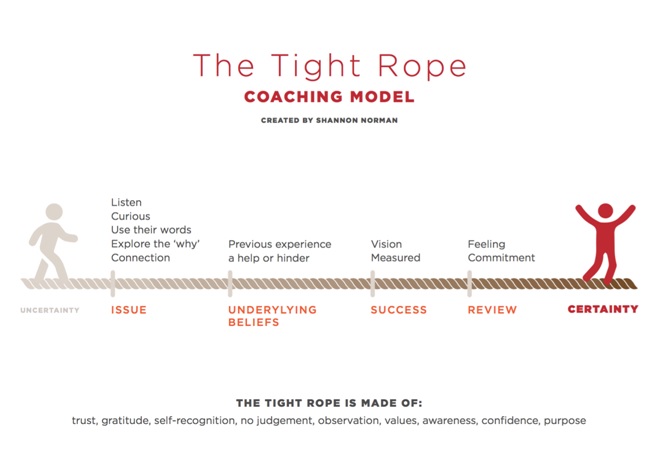A Coaching Model Created by Shannon Norman
(Inclusion of Women in Leadership Coach, UNITED STATES)
The Tight Rope Coaching Model was designed by uniting my personal values, beliefs, and style along with my learning from ICA. The model represents the importance of maintaining focus on key steps towards certainty. The rope is made of crucial components to ensure it remains tight to prevent the client from falling and tension in the coach/client relationship. The metaphor reflects the constant balance and needs for flexibility.

We must first understand what the tight rope is made of. It is intertwined with various coaching presence and skills to provide the foundation necessary for the client to be successful. The rope is made of trust, gratitude, self-recognition, no judgment, observations, values, awareness, confidence, and purpose. Each piece of twine is further explained below:
Trust is the foundation or center of the rope. We all become trusting of others at different times; some sooner and some later. Trust grows over time by modeling what was agreed to and treating one another with the utmost respect.
Gratitude is expressing kindness. Kindness is essential in trusting relationships. A grateful outlook generally fosters better outcomes and a positive mindset. Openness to new perspectives is more likely when gratitude is present.
Self-recognition is imperative for one to be resilient. Celebrating even small successes builds positive momentum. It is human nature to thrive on recognition and many times we are our own worst critic. Self-recognition suffocates negative self-talk and stimulates higher self-esteem.
No judgment creates a safe space, nurturing a trusting relationship. People refrain from being themselves and sharing key pieces of information that may be insightful in helping them reach their goals when they feel judged. A no judgment environment supports creativity and innovative ideas because of the lack of fear of what others may think.
Observations help promote self-reflection. Observations are not feedback and are judgment-free. There is a certain level of significance when someone restates a thought using the same words or calls out a noticeable shift in energy. This type of observation may offer a turning point where new thoughts are identified or clarity is gained.
Values are intangible but significant in all relationships. They are seen through how a person interacts and treats others. The most effective way to model our values is to “walk the talk”. Our actions must align with what we say.
Awareness is essential. Being aware includes listening to keywords and asking specific questions to help focus on the areas most likely to move forward in obtaining the desired outcome. At times, there may be a level of discomfort in seeking increased awareness; keep moving forward as long as values are aligned and the outcome is the focus.
Confidence is contagious. A coach must have a high level of confidence to inspire others to obtain their goals. Confidence is similar to values in regards to how others measure it. A confident coach leads to a confident client. The positive energy from a confident coach will likely carry over to the client.
The purpose is the outer protective layer of the rope that holds it all together. The art of knowing and staying in touch with one’s purpose will keep the rope strong. A coach with a purpose provides a strong tight rope modeling the coaching presence and skills to inspire the client.
Next, is an overview of the steps along the tight rope.
The model begins with uncertainty. An issue is identified, underlying beliefs are considered, a vision of success is described, followed by a review including the level of commitment and the session is then wrapped up. The model ends with certainty.
Now, to further explore the above steps moving from uncertainty to certainty.
-
Issue
The client identifies an issue. The coach listens intently and remains curious asking specific questions to dig deeper into the meaning of what is being shared. The coach exhibits active listening by using the client’s words and explores the ‘why’ and the connection and meaning between the client and the issue. The client shares the desired outcome. The coach directly communicates to ensure agreed understanding.
-
Underlying Beliefs
Powerful questions asked by the coach help uncover any underlying beliefs including previous experiences that may help or hinder the client in reaching their desired outcome. The same questions may open the client’s mind to alternative perspectives and/or increased awareness.
-
Success
The coach asks questions to help the client describe what success looks like when the outcome is achieved. The exchange of questions and responses may generate ideas or new learnings for the client. The coach helps the client stay focused on what is within their control and what actions are worth considering. A visionary exercise may be beneficial to promote positive emotions.
-
Review
This step pulls it all together. The coach asks about the level of commitment on identified actions including potential barriers. The coach may need to ask multiple questions to help the client make a commitment, consider how to stay on track and who may be able to support them.
The Tight Rope Coaching Model emphasizes the coaching presence and skills necessary to encourage a healthy relationship between the coach and client. Without one of the twines, the rope becomes weak and the relationship is at risk. A strong tight rope is made up of each separate twine-wrapped together with an outer protective layer. The model also includes steps to stay on track and assist the client in gaining certainty. While the steps are important, the order may not occur succinctly. If the client offers some of the necessary information, the coach should listen and move naturally through the steps, pivoting when appropriate. Successful navigation along the rope must include both constant balance and flexibility.